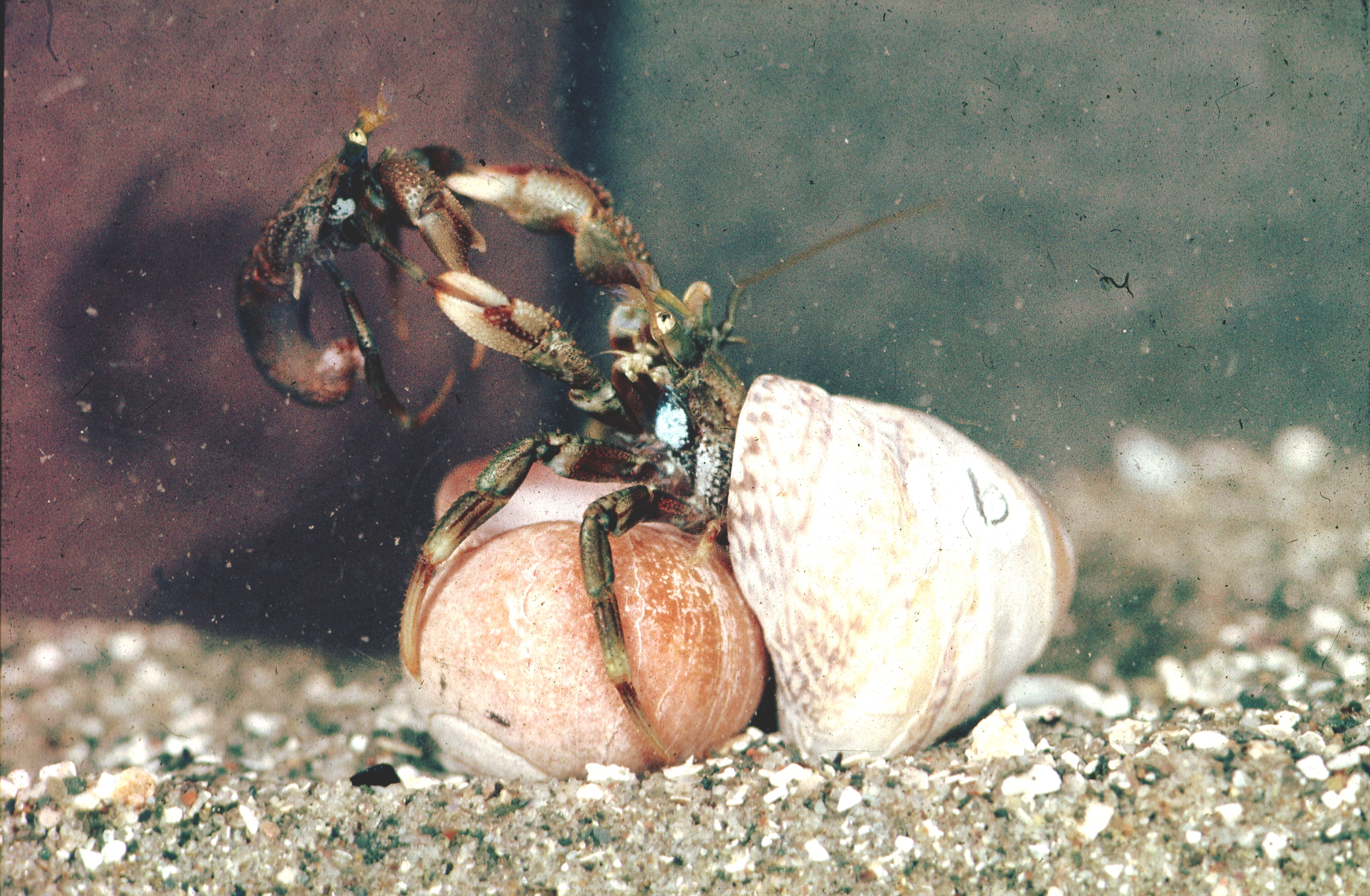Efforts to resolve questions about animal behavior, especially contest behavior, invite collaboration between mathematicians and biologists using analytical tools called games [1]. A game in this context is a mathematical model of strategic interaction, which arises whenever the outcome of one individual's actions depends on actions to be taken by others. In my research, usually that one individual is a non-human animal, and the others are the rest of its population. Constructing such games is the focus of my work.
Once a game has been constructed, the goal is to find an evolutionary stable strategy or ESS—broadly speaking, a population strategy yielding a higher reward than any feasible alternative. Much game-theoretic literature deals with games that are simple in the sense that interaction is assumed to be dyadic, role asymmetry (if any) is assumed to be static, and intrinsic variation among individuals in, e.g., fighting ability—aka resource holding potential or RHP—is assumed either to be absent or to have no affect on payoffs (thus, for example, weak individuals and strong individuals would both be aggressive half the time if the ESS called for aggressive behavior with probability 0.5). If any of these three assumptions is relaxed, then—largely for want of a better phrase—I say that the game is complex; and this is the sense in which complex games are the primary focus of my research. Of course, the phrase is most apt when all three assumptions are relaxed. Indeed polyadicity, role-change dynamics and intrinsic variation are merely three of many factors that make strategic interactions complex; and insofar as these are the only complexifying factors that I tend to consider, perhaps what I do is best described as simple complex games!
Typically, a well designed model has an ESS that, albeit unique, varies across ecological parameter space. Through such variation, game-theoretic models capture differences across real populations in behavior that has evolved by natural selection. In this regard, recent and ongoing collaborative work explores the following overlapping themes.
Triadic games: As noted above, much game-theoretic literature deals only with dyadic interactions, which preclude network effects (but are perfectly adequate for studying many other aspects of contest behavior). Because triads are both the smallest groups in which network effects arise and the groups beyond dyads for which analytical models are most likely to be tractable—especially when allowing for intrinsic variation in RHP—a major thrust of recent work has been developing triadic games, in collaboration with Tom Sherratt. Insights gleaned from these models are summarized in [2] and [3]. For example, animals are known to gather information through eavesdropping. We were motivated to model such behavior by an earlier game-theoretic model, which counterintuitively predicted that eavesdropping increases the frequency of mutually aggressive contests. However, this conclusion was predicated on zero variance of strength. Allowing for such variation, we showed instead that eavesdropping reduces aggression [4]. Again, it is known that often two animals form a pact against a third. Somewhat counterintuitively, we predicted that the probability of such a pact is higher when there exists a degree of antergy in combining fighting strengths—the effective strength of a coalition is less than the sum of the individual strengths of the pair—and is especially high when variance in strength and reliability of strength difference as a predictor of fight outcome are both also high [5]. Yet these conditions do appear to characterize coalitions found in primate societies.

Two male fiddler crabs grappling. The male on the right is a territory owner, the male on the left a floating intruder without a territory. (Tanya
Detto, courtesy of Pat
Backwell)
|
Coalition or alliance formation theory is discussed more generally in [7].

(Photo courtesy of Andrew Ross) |
The aforementioned model was one of a suite of twelve (arising from two interaction patterns, three payoff and two information structures) developed in [9] to assess how inter-individual variation in RHP affects the propensity to share or otherwise cooperate. These models have yielded numerous insights. For example, increasing variance of RHP can promote cooperation, inhibit it, or have no effect (though only if costs are constant, so that the probability of cooperation is independent of variance); somewhat counterintuitively, precluding fights between hawks and doves can decrease the level of cooperation; and ignorance can be more conducive to cooperation than partial knowledge.
|
(Video courtesy of Kevin Judge) |
A more recent model [11] relaxes two assumptions of our earlier Model B.

Two male Jackson's chameleons (Chamaeleo jacksonii) push each other in a contest of strength. (Photo courtesy of Devi
Stuart-Fox)
|

A shell fight between two hermit crabs (Pagarus bernhardus) in which the defender has been pulled from its shell. (Photo courtesy of Bob Elwood)
|
Respect for Ownership: Respect for property is widespread in the animal kingdom even without any third-party enforcement [13]. Owners are frequently left unchallenged by potential competitors, and tend to win contests when disputes arise. Game theory shows that respect for ownership—Bourgeois behavior—can arise as an arbitrary convention to avoid costly disputes. However, the same theory predicts that a paradoxical respect for lack of ownership—anti-Bourgeois behavior—can evolve under the same conditions, and in some cases is the only stable outcome. Despite these predictions, anti-Bourgeois behavior is rare in nature, whereas respect for ownership is common. A frequently invoked resolution of this paradox is that two individuals employing anti-Bourgeois behaviour over repeated rounds would be swapping roles continually, a potentially inefficient outcome known as infinite regress. Another potential resolution is that there is often confusion over ownership in the natural world, mediated for example by the temporary absence of a true owner. Further games, again in collaboration with Tom Sherratt, explore the validity of these verbal rationales by explicitly modelling role-change dynamics with infinite regress [14][15] or confusion over ownership [16][17]. What the models show is that although either infinite regress or mistakes over ownership can facilitate the evolution of Bourgeois-like conventions, neither seems to fully explain the extreme rarity of anti-Bourgeois behavior in nature.
Work in progress: Ongoing collaborative projects are a mix of revisiting previously studied themes and branching out in new directions. For example, I have been using game-theoretic modelling to explore territory size and shape in convict cichlids, in collaboration with Yao Dai [18]; musth in male elephants, in collaboration with Max Wyse, Ian Hardy and Lisa Yon [19]; and volatile chemical emissions as weapons of rearguard action, in collaboration with Yao Dai, Ian Hardy and Marlène Goubault [20].
REFERENCES
(full text downloadable from here in most cases)- M. Mesterton-Gibbons and E.S. Adams. Animal contests as evolutionary games. American Scientist 86, 334-341. BACK
- M. Mesterton-Gibbons and T. N. Sherratt. Animal network phenomena: insights from triadic games. Complexity 14, 44-50. BACK
- T. N. Sherratt and M. Mesterton-Gibbons. Models of Group or Multi-Party Contests. In Animal Contests (I.C.W. Hardy and M. Briffa eds, Cambridge University Press), in press. BACK
- M. Mesterton-Gibbons and T. N. Sherratt. Social eavesdropping: a game-theoretic analysis. Bulletin of Mathematical Biology 69, 1255-1276. BACK
- M. Mesterton-Gibbons and T. N. Sherratt. Coalition formation: a game-theoretic analysis. Behavioral Ecology 18, 277-286. BACK
- M. Mesterton-Gibbons and T. N. Sherratt. Neighbor intervention: a game-theoretic model. Journal of Theoretical Biology 256, 263-275. BACK
- M. Mesterton-Gibbons, S. Gavrilets, J. Gravner and E. Akçay. Models of coalition or alliance formation. Journal of Theoretical Biology 274, 187-204. BACK
- M. Mesterton-Gibbons and T. N. Sherratt. Divide and conquer: when and how should competitors share? Evolutionary Ecology 26, 943-954. BACK
- M. Mesterton-Gibbons and T. N. Sherratt. Information, variance and cooperation: minimal models. Dynamic Games and Applications 1, 419-439. BACK
- M. Mesterton-Gibbons and T. N. Sherratt. Victory displays: a game-theoretic analysis. Behavioral Ecology 17, 597-605. BACK
- M. Mesterton-Gibbons and T. N. Sherratt. Signalling victory to ensure dominance: a continuous model. Annals of the International Society of Dynamic Games 12, 25-38. BACK
- M. Mesterton-Gibbons and S. M. Heap. Variation between self- and mutual assessment in animal contests. American Naturalist 183, 199-213. BACK
- T. N. Sherratt and M. Mesterton-Gibbons. The evolution of respect for property. Journal of Evolutionary Biology 28, 1185-1202. BACK
- M. Mesterton-Gibbons and T. N. Sherratt. Bourgeois versus anti-Bourgeois: a model of infinite regress. Animal Behaviour 89, 171-183. BACK
- M. Mesterton-Gibbons, T. Karabiyik and T. N. Sherratt. On the evolution of partial respect for ownership. Dynamic Games and Applications 6, 359-395. BACK
- M. Mesterton-Gibbons, T. Karabiyik and T. N. Sherratt. The iterated Hawk-Dove game revisited: the effect of ownership uncertainty on Bourgeois as a pure convention. Dynamic Games and Applications 4, 407-431. BACK
- M. Mesterton-Gibbons and T. N. Sherratt. How residency duration affects the outcome of a territorial contest: Complementary game-theoretic models. Journal of Theoretical Biology 394, 137-148. BACK
- M. Mesterton-Gibbons and Y. Dai. An effect of landmarks on territory shape in a convict cichlid. Bulletin of Mathematical Biology 77, 2366-2378. BACK
- J. M. Wyse, I.C.W. Hardy, L. Yon and M. Mesterton-Gibbons. The impact of competition on elephant musth strategies: a game theoretic model. Journal of Theoretical Biology 417, 109-130. BACK
- M. Mesterton-Gibbons, Y. Dai, I.C.W. Hardy and M. Goubault. Volatile chemical emission as a weapon of rearguard action: A game-theoretic model of contest behavior. Click here for unpublished manuscript. BACK
Last updated March 16, 2017.